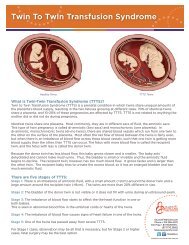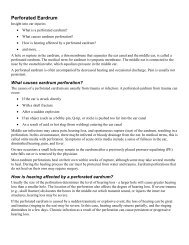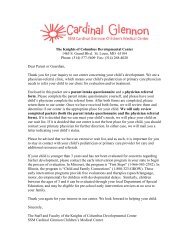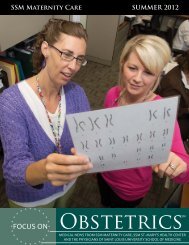perinatal-times_2013-03_print_and_read - SSM Cardinal Glennon ...
perinatal-times_2013-03_print_and_read - SSM Cardinal Glennon ...
perinatal-times_2013-03_print_and_read - SSM Cardinal Glennon ...
Create successful ePaper yourself
Turn your PDF publications into a flip-book with our unique Google optimized e-Paper software.
characteristic of the FHR baseline, <strong>and</strong> as such it shouldnot be used to describe decelerations. According to Tucker,Miller & Miller (2009) the appearance of variability duringa deceleration has not been studied, <strong>and</strong> they discourageassigning undue significance to its occurrence. The moderatebaseline variability in this strip is highly predictive of theabsence of fetal metabolic acidemia.In strip #2 the baseline FHR is 155 bpm, the variability isminimal, there is one acceleration near the end of the strip<strong>and</strong> there are recurrent late decelerations (Category II). Somemight question the presence of late decelerations. Theyare subtle, the onset to nadir is about 25 seconds <strong>and</strong> thetiming appears to be delayed. This doesn’t completely fit thedefinition of a late deceleration, but these characteristicsdon’t completely fit any of the definitions of the four typesof decelerations. What do you do when a decelerationpattern doesn’t quite fit any of the definitions perfectly?Use your clinical judgment to most accurately label thedeceleration pattern, continue appropriate interventions <strong>and</strong>observe closely. It is imperative that this type of tracing bereviewed <strong>and</strong> discussed by all members of the care team.Communication among care providers is paramount especiallywhen there may be variation in the assessment, interpretation<strong>and</strong> plan of care.OUTCOMEInterventions in this situation included lateral positioning, IVfluid bolus <strong>and</strong> the administration of oxygen. Within about30 minutes the FHR returned to a baseline of 140 bpm,with moderate variability, occasional accelerations <strong>and</strong> noadditional late decelerations. The contractions became moreirregular with minimal change in her cervical exam.Oxytocin was administered <strong>and</strong> approximately 5 hours afterinitiation Ms. L was completely dilated. Shortly thereafter ababy boy was delivered vaginally with Apgar scores of 8 <strong>and</strong>9 at 1 <strong>and</strong> 5 minutes respectively. He weighed 4200 grams.Mom <strong>and</strong> baby had a normal postpartum course <strong>and</strong> weredischarged on day 2. ●REFERENCETucker, S.M., Miller, L.A., & Miller D.A. (2009). Fetal monitoring: A multidisciplinaryapproach (6th ed.). St. Louis, MO: Mosby Elsevier.ABOUT THE AUTHORSharon Rector is an Education Consultant specializing in <strong>perinatal</strong> nursing at <strong>SSM</strong>Health Care in St. Louis.TRACING 2THE PERINATAL TIMES | 7
















